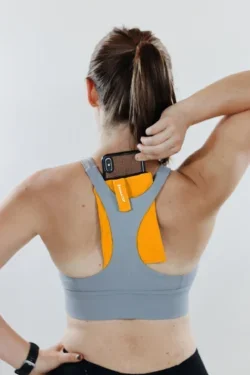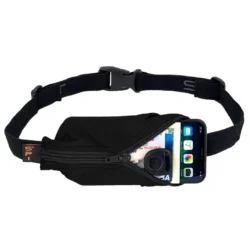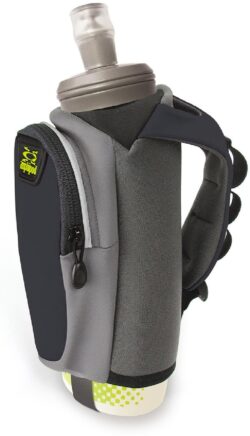Products You May Like
Get access to everything we publish when you
sign up for Outside+.
If laundry baskets could talk, we’re sure they’d have some words to share about the state of the clothes they see from runners. But in our defense, runners like to push it. Whether we’re up with the sun for a 5 a.m. track workout, or a triple digit long run in all of our sweaty glory, we face extreme conditions, and our equipment must do the same.
But while our tech running shoes and moisture wicking running apparel were built for the demands of an athletic lifestyle, our smartphones were not. Raise your hand if you’ve ever dropped your phone, cracked your screen, or finished a workout to find your phone soaked in sweat… Don’t feel bad. We’re here to help.
Check out a few common scenarios, discover how to fix the problem, and prevent it from from happening again.
RELATED: Safety Apps Can Keep Track of Your Whereabouts
Your phone overheats during a hot run
After your ride, you pull up your phone to check out your stats, but all you see is a black screen and an error message that says something like: EXTREME TEMPERATURE! Phone must cool down before use.
Tyler Kixmiller, a Wireless Industry Service Excellence level 3 certified technician, explains that your smartphone has built in protection to prevent it from overheating. If the interior temperature of the phone exceeds normal operating range, the device will shut down to protect its internal components. For example, for Apple iOS devices, this range is 32°F-95°F.
“All cellphones use a lithium battery,” Kixmiller explains. “These batteries have a safety feature that when they get hot, they automatically stop, or freeze. This is because lithium can be highly flammable, especially under intense pressure, or if it gets punctured. Heat and lithium do not go well together, and that’s why cell phones have this safety feature.”
If the phone’s interior temperature goes outside of its normal operating range, you might notice changes like a dim display, a black screen with an error message, charging problems, or a disabled navigation display. At this point, the only operation your phone will support is making an emergency call.
To resume using your phone as soon as possible, take it out of the hot environment, away from sunlight, and allow it to cool down. Keep in mind that using your phone in very hot conditions can permanently shorten battery life.
“What happens when that safety feature fails, or even with overcharging, is that the battery starts to swell,” Kixmiller says. “A battery isn’t going to charge well under intense heat. As a result, a lot of people will see the screen begin to separate or the back of the phone will start to bend, because the battery is swelling.”
Your phone fell in water

Accidentally taking your phone for a swim isn’t as dire as it might seem. Most newer phone models have improved their water resistance capabilities. The Apple iPhone 12 and 13 have a max depth rating of 6 meters for up to 30 minutes, and the Samsung Galaxy S22 Ultra and Google Pixel 6 Pro have a 1.5-meter rating for 30 minutes. You probably don’t want to test this out on purpose, but it does provide some peace of mind.
However, what you do after your phone gets wet could cause more harm than good. Don’t attempt to dry your phone with an external heat source, like a hair dryer, or compressed air. Don’t put a foreign object like a cotton swab into any port on the phone.
If your phone gets wet, tap it against your hand with the charging port facing down to remove excess liquid. Then, place the phone in front of a fan with the port facing airflow, and make sure the phone is completely dry before opening the SIM card slot.
However, if your phone has sustained significant water damage, there isn’t an easy fix. “Literally, the newer smartphones are just a screen, on top of a frame, sealed by a thin layer of adhesive,” Kixmiller says. “If a phone gets water damage, there isn’t much you can do. Although the phone might work initially, most of the time, the water has already affected the battery and begun to spread to the motherboard.”
Kixmiller says the best bet is using a good, old bag of rice, as a last resort. “Give it a solid 24 hours to absorb as much moisture as possible. Most of the time, this method might end up saving a phone, but most people aren’t willing to wait that long. They will hook the phone up to a charger before it’s fully dry. That’s really bad, because if there’s any moisture, you’re sending power through the phone before it’s dry.”
Charging a phone while it’s still wet can lead to corrosion of the pins inside the port, which can cause permanent damage or future connectivity issues.
You dropped your phone while running and cracked the screen.
Most phones are made of pretty durable materials, but a significant impact can cause external and internal damage. If you carry your phone during workouts, invest in a sturdy phone case and a screen protector, which is designed to shatter and protect your phone.
For athletes who take their phones along on workouts, Kixmiller suggests getting a phone case that seals off the phone’s openings from the environment. “This type of protection fully encases the phone and is very good at keeping out debris, moisture, and sweat,” he says. “Otterbox is one of the best cases out there.”
Another essential is a tempered glass screen protector that extends to, and covers, the curved edges of the phone, instead of a polymer film that simply sits on the screen. Tempered glass also provides the added bonus of excellent scratch resistance and a hydrophobic coating that protects against smudges, oil, and moisture.
“The tempered glass will break too, but this type of screen protector secures more tightly to the screen. If the phone is dropped, it will break before the screen will,” he says.
If your screen sustains a significant crack, the only solution is to pay to have the screen replaced. This is especially important for any smartphone that relies on a touch screen with internal sensors.
You put your phone in a pocket – now it’s covered in sweat and small scratches
Most smartphones have a touch screen that features glass with a textured finish. Even with normal use, this surface can show signs of material transfer from the objects that come into contact with your phone, like your jersey pocket, especially when oil and sweat is involved. But what appear to be small surface scratches can be removed in most cases.
The touch screen of most smartphones has an oil repellent coating on the surface, and using harsh cleaning products can diminish the coating and cause scratches. However, you can use a 70% isopropyl alcohol wipe to clean the exterior surface of your phone after a sweaty workout.
“Alcohol wipes are great, because they pretty much dry instantly,” Kixmiller says. “Because smartphones have so many openings, you’re going to get some moisture within the phone naturally. But using an alcohol wipe is a great way to clean and sanitize.”
Your phone used to hold a charge for long runs, but now the battery drains quickly.
While lithium-ion batteries are long lasting and rechargeable, they do have a lifespan, and their capacity and performance will decline over time. While battery life is the amount of time a device can run before it needs to be recharged, battery lifespan is the amount of time a battery will last until it needs to be replaced.
Go into your phone’s settings and look for Battery or Battery Health. Most newer phones will say 100%, but as that number dips below 80%, performance begins to deteriorate, and the battery might need to be replaced.
Also, there’s a common practice you likely do every day that’s damaging your battery. “Overcharging is something we’re all guilty of,” Kixmiller says. “Think about what you do when you go to bed at night. You probably plug in your phone and don’t remove it from the charger until morning. However, sometime during the middle of the night, the battery was fully charged. Any point beyond that is considered to be overcharging. Ideally, you want to charge a phone up to 100%. Then, remove it and use the phone until it gets to the 5-10% mark, and then recharge.”
Another common error that leads to a reduction in battery performance is using a phone while it’s actively charging. “When a battery starts to get low, people often hook their phone up to a charger and use the phone while it’s charging,” Kixmiller says. “That can damage the battery as well.”
“The number one thing to remember with batteries is that most have an average lifespan of two to three years. Batteries lose capacity, so at that two or three-year mark, you might notice that the phone doesn’t hold a charge as well as it used to.”
How to improve your phone’s battery life:
- Update to the latest software.
- Adjust screen brightness.
- Use Wi-Fi instead of a cellular network, when possible.
- Don’t use a third-party charging cable.
- Don’t leave your phone on the charger all night.
- Turn off location services and background refresh for apps you don’t use often.
How to (safely) carry your phone on a training run
There are a number of products that can help protect your phone while you run
Brooks Dare Pocket Bra
$50, Brooks.com

The Koala Clip
$29, koalaclip.com

This sweat-resistant pouch with a clip allows you to attach your phone to the back of your sports bra or jersey pocket.
SpiBelt
$27, spibelt.com

This waist pouch (or “fanny pack,” if you’re feeling retro) is a favorite among runners because of its low-profile design, and it comes in fun colors and patterns.
Amphipod Hydraform Soft-Tech Water Bottle
$40, rei.com

If you’re looking for a handheld water bottle that can also carry your phone, try this double-duty offering from Amphipod.
